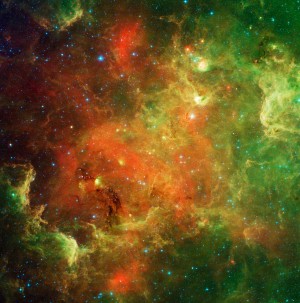Posts Tagged ‘Sky Tonight’
Sky Tonight—May 17, Bright moon near the

Courtesy of EarthSky A Clear Voice for Science Visit EarthSky at www.EarthSky.org The moon will look plenty full tonight, though it will really be a waning gibbous moon that lights the sky. Watch it rise in the southeast some time after sunset. The moon rides low above the horizon in mid-northern latitudes. If your southeastern horizon is rather cluttered, you might have to wait a few to several hours after sunset for the brilliant orb to clear any obstacles. Looking for a sky almanac? EarthSky ... Full Story
Sky Tonight—May 16, Will you see a fuller moon

Courtesy of EarthSky A Clear Voice for Science Visit EarthSky at www.EarthSky.org Photo from yourdon’s photostream Your calendar probably says that full moon is tomorrow, Tuesday, May 17, 2011. However – depending on where you live and what time you look – you might see a fuller moon tonight. That is true for us in North America. Full moon falls at or shortly before dawn on May 17 for us. So tonight’s moon is slightly more full than the moon tomorrow night – even though the calendar ... Full Story
Sky Tonight—May 15, Earth shadow, Belt of Venus in

Courtesy of EarthSky A Clear Voice for Science Visit EarthSky at www.EarthSky.org Here’s a lovely photo of the Earth’s shadow, which can be seen any clear evening ascending in the eastern sky at exactly the same rate that the sun sets below the western horizon. The shadow is a deep blue-grey – darker than the blue of the twilight sky. The pink band above the shadow is called the Belt of Venus. The shadow of the Earth is big. You might have to turn your head to see the whole thing. The ... Full Story
Sky Tonight—May 13, Moon near golden Saturn

Courtesy of EarthSky A Clear Voice for Science Visit EarthSky at www.EarthSky.org You’ll find the moon in a waxing gibbous phase this evening – more than half lighted but less than full – in the sky from sunset until after midnight. Tonight’s moon will be visible near a bright object in our sky. It is not a star, but a planet – Saturn, planet of the rings. Given clear skies, almost everyone around the world can see the moon and Saturn near each other this evening. Earth passed between ... Full Story
Sky Tonight—May 12, How to see the green flash

Courtesy of EarthSky A Clear Voice for Science Visit EarthSky at www.EarthSky.org The image today is a classic image of a detached green flash, seen at sunset. You can see green flashes with the eye, sometimes, if you are looking toward a very clear horizon. You must be looking just at sunset, at the last moment before the sun disappears below the horizon and you have to be careful not to look too soon. Wait until just the thinnest rim of the sun appears above the horizon. If you look too soon, ... Full Story
Sky Tonight—May 11, Moon brushes the belly of Leo

Courtesy of EarthSky A Clear Voice for Science Visit EarthSky at www.EarthSky.org The moon is waxing larger in the evening sky each night. The first quarter phase happened yesterday, and now it is a waxing gibbous moon. Tonight’s moon is near the star Regulus and brushing up against the belly of the constellation Leo the Lion throughout the evening. Regulus is the brightest star in the constellation Leo the Lion. It dots the backward question mark of stars dubbed the Sickle. The Sickle is ... Full Story
Sky Tonight—May 6, Mercury at greatest morning

Courtesy of EarthSky A Clear Voice for Science Visit EarthSky at www.EarthSky.org Mercury, the solar system’s innermost planet, reaches its greatest western elongation from the sun on Saturday, May 7. Because Mercury is farthest west of the sun at present, this world now rises into the morning sky before sunrise – but how much before depends on where you live on the globe. The farther north you live, the closer Mercury rises to sunrise. The farther south you live, the greater the period of ... Full Story
Sky Tonight—May 5, Eta Aquarid meteor shower best

Courtesy of EarthSky A Clear Voice for Science Visit EarthSky at www.EarthSky.org Photo courtesy of tonynetone’s photostream The annual Eta Aquarid meteor shower is expected to produce the most meteors before dawn tomorrow (Friday, May 6). But – because these meteors have a relatively broad maximum – you can look for some Eta Aquarids before dawn on Saturday, too. Planets visible at dawn: Venus and possibly Mercury and Jupiter The Eta Aquarid meteors are strictly for night owls or early ... Full Story
Sky Tonight—May 4, Find Eta Aquarid meteor shower

Courtesy of EarthSky A Clear Voice for Science Visit EarthSky at www.EarthSky.org The Eta Aquarid meteor shower is now taking stage in the wee hours before dawn. It has expected to peak in the predawn sky on Friday morning – May 6, 2011 – in the dark hour before astronomical twilight. Don’t know when astronomical twilight begins in your sky? Find out with this handy custom sunrise sunset calendar. Under ideal conditions, this shower may produce up to 20 to 40 meteors per hour. Even higher ... Full Story
Sky Tonight—May 1, Star hopping from constellation

Courtesy of EarthSky A Clear Voice for Science Visit EarthSky at www.EarthSky.org Rebecca wrote, “What is ‘star hopping?’ What does that mean?” Rebecca, amateur astronomers use star hopping to go from stars and constellations they know … to ones they do not know yet. First, look for noticeable patterns on the sky’s dome. One very easy pattern to find at this time of year is the constellation Orion the Hunter. You will find it descending in the west after sunset. Orion is easy to ... Full Story








